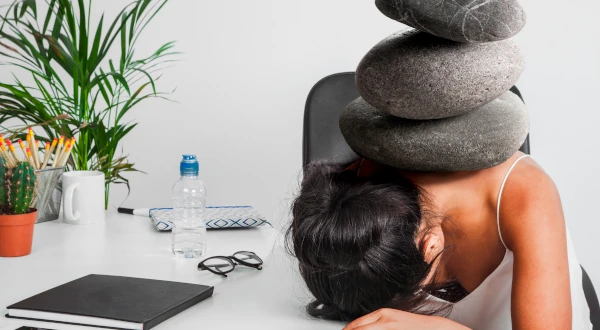Sleep problems are a common experience for millions of people worldwide. Data from NHS Digital revealed alarming statistics in 2022: over 34.0% of children aged 7 to 16 experience sleep difficulties three or more nights a week. The situation was even more prevalent among young adults aged 17 to 23, with 64.0% reporting similar frequent sleep disturbances.
Achieving quality sleep has become a significant challenge for many individuals. This has led to an increased exploration of various strategies and remedies to improve sleep, with white noise emerging as a popular option. By understanding the science behind white noise and its potential impact on sleep, individuals can decide whether incorporating this sound therapy into their nightly routine could be beneficial.
What is white noise?
White noise is a constant, ambient sound that contains a balanced blend of all audible frequencies at equal intensity. It’s often compared to the static hiss from an untuned television or radio or the consistent, steady sound of a fan or air conditioner. Other common examples of white noise include the gentle rush of waves, the soft patter of rain, or the soothing rhythm of a waterfall.
Other types of colour noises
While white noise is a specific type of sound, the term is sometimes used more broadly to encompass various other types of ambient noise, known as “colour noises.” These variations differ in frequency and intensity distributions, creating distinct auditory experiences.
While traditional white noise can be effective for some individuals in promoting relaxation and better sleep, personal preferences can vary widely regarding different types of ambient noise. Some people may find certain colour noises, such as pink noise or brown noise, more soothing or conducive to restful sleep than pure white noise.
Pink noise
It is often described as a deep, rumbling sound of steady rainfall or ocean waves. Some believe the gentle, consistent nature of pink noise to be more soothing and natural-sounding than pure white noise. It can evoke a sense of immersion in a natural environment, which may be particularly calming for some individuals.
Brown Noise
It is a more profound, bass-heavy variation of pink noise, mimicking the low roar of strong winds or a cascading waterfall. The deep, rumbling tones of brown noise are particularly effective at masking low-frequency sounds like traffic noise or snoring, making it a potential choice for those living in urban or noisy environments.
Green Noise
It is a more balanced blend of high and low frequencies, often considered the most natural-sounding colour noise. It is sometimes compared to the ambient sounds of a rainforest or natural environment, with a rich tapestry of various frequencies blending seamlessly.
Blue Noise
A higher-frequency variation emphasising the mid-range and treble frequencies. It is often described as having a more “crisp” or “atmospheric” quality, akin to the sound of gentle wind or rustling leaves.
Why does white noise help you sleep?
One of the primary reasons white noise is believed to aid in sleep is its masking effect. By producing a consistent, ambient sound, white noise can effectively drown out or mask other disruptive noises that might otherwise interfere with sleep, such as traffic, barking dogs, or a partner’s snoring. This can be particularly beneficial for light sleepers or those living in noisy environments, as the constant white noise buffers against intermittent disturbances that can disrupt sleep cycles.
Additionally, white noise creates a neutral auditory environment that can promote relaxation and make it easier for the mind and body to transition into a restful state. The constant, non-threatening sound may provide a sense of familiarity and security, potentially reducing stress and anxiety levels that can contribute to sleep disturbances.
Effects of white noise on the brain
White noise has been used as a potential aid for improving sleep quality and duration. It is thought to promote relaxation and reduce stress levels, creating an environment more conducive to falling and staying asleep. The constant, soothing sound can mask disruptive external noises interfering with sleep initiation and maintenance. White noise may help to stabilise sleep patterns by providing a consistent auditory backdrop for individuals with tinnitus or misophonia. It enhances slow-wave sleep, the deepest and most restorative stage, improving cognitive function.
However, white noise is not without its potential drawbacks. Some individuals may find the sound disruptive or unnatural, potentially disrupting sleep rather than aiding it. Personal preferences play a major role in determining its effectiveness as a sleep aid. Additionally, excessive volume or prolonged exposure could contribute to hearing issues or tinnitus. White noise may also mask important sounds like alarms or a crying baby, posing safety concerns. For certain people, it could inadvertently trigger associations with unpleasant sounds, increasing anxiety or restlessness. There is also the risk of developing a dependency on white noise for sleep, making it difficult to sleep in silence.
Benefits of white noise
The potential benefits can be significant and far-reaching for those who find white noise helpful. In addition to promoting relaxation and masking disruptive noises, white noise may provide the following advantages.
Improved sleep quality and duration: White noise can improve the overall quality and duration of sleep, leading to feeling more rested and refreshed upon waking. Adequate sleep is crucial for overall physical and mental health, cognitive function and performance.
Faster sleep onset: White noise can aid in falling asleep faster by reducing the time spent tossing and turning. This can be particularly valuable for individuals struggling with sleep-onset insomnia or racing thoughts at bedtime.
Sense of familiarity and security: For individuals struggling with anxiety or stress-related sleep disturbances, white noise can provide a sense of familiarity and security. The consistent, predictable nature of white noise can help to calm the mind and create a sense of safety.
Relief from intrusive sounds: White noise relieves those with tinnitus or other conditions involving persistent ringing, buzzing, or other intrusive sounds. By masking these disruptive noises, white noise can create a more peaceful auditory environment for sleep.
Noise masking for disruptive environments: White noise can help create a more peaceful sleep environment for individuals living in noisy environments, near construction sites, or with loud neighbours. It can significantly reduce the impact of external disturbances on sleep quality.
Potential benefits for sleep disorders: White noise may benefit individuals with certain sleep disorders, such as insomnia or sleep apnea, by promoting deeper, more restorative sleep and reducing instances of waking during the night.
Enhanced cognitive performance: By improving overall sleep quality, white noise can indirectly enhance cognitive performance and alertness.
Reduced reliance on sleep medications: White noise may reduce the need for sleep medications or other sleep aids, which can have undesirable side effects and the potential for dependence or tolerance over time.
Versatile sleep aid for various settings: The portable nature of white noise machines can make them a versatile sleep aid, facilitating sleep in various settings, such as hospitals, long-term care facilities, or even offices where individuals may need to nap or rest during the day.
How do you choose a white noise machine?
If you’re considering using white noise to aid sleep, choosing the right device can significantly affect its effectiveness and overall user experience. Some advanced white noise machines may offer additional features like sleep tracking, gentle wake-up alarms, or the ability to create custom sound mixes. Some white noise machines include white noise apps for smartphones or tablets and more basic solutions like using a fan, air conditioner, or sound machine that simulates natural sounds like rain or ocean waves.
Sound variety: Look for machines that offer a range of sound options, including traditional white noise, nature sounds (like rain or ocean waves), or other colour noises. This versatility allows you to experiment and find the most soothing sound or combination of sounds for your preferences.
Volume control: Adjustable volume is crucial, as too loud white noise can lead to noise-induced hearing loss. Look for machines with precise volume controls, preferably a dial or slider, to fine-tune the sound level to your ideal setting.
Timer function: Many white noise machines include a timer function, allowing you to turn the device off automatically after a certain period. This feature can be useful for those who only require white noise to fall asleep initially or to prevent excessive exposure throughout the night.
Portability: If you frequently travel or need white noise in multiple locations, consider a compact, portable machine that can be easily transported and used on the go. Look for models with battery power options or USB connectivity for added convenience.
White noise and sleep – is it real?
While the use of white noise for improving sleep is a popular and growing trend, it’s crucial to understand that its effectiveness can vary from person to person. Some individuals may find white noise incredibly helpful for promoting relaxation and masking disruptive noises, while others may find it disruptive or ineffective. More comprehensive approaches may be necessary for those experiencing persistent or severe sleep disturbances.
While white noise can be a valuable tool for many individuals, it should not be viewed as a solution for all sleep problems. In persistent or severe sleep disturbances, addressing any underlying medical conditions or seeking professional guidance from a sleep specialist is essential.
As a leading sleep physician and psychiatrist, we offer consultations for those experiencing persistent sleep difficulties. We can help identify the underlying causes of your sleep issues and recommend personalised strategies, which may include white noise or other sleep-promoting techniques. We can also work together to address any underlying medical conditions or lifestyle factors contributing to your sleep disturbances.










